
Robert Persons, later known as Robert Parsons, was an English Jesuit priest. He was a major figure in establishing the 16th-century "English Mission" of the Society of Jesus.
This article contains information about the literary events and publications of 1587.

The National Library of Wales, in Aberystwyth, is the national legal deposit library of Wales and is one of the Welsh Government sponsored bodies. It is the biggest library in Wales, holding over 6.5 million books and periodicals, and the largest collections of archives, portraits, maps, and photographic images in Wales. The Library is also home to the national collection of Welsh manuscripts, the National Screen and Sound Archive of Wales, and the most comprehensive collection of paintings and topographical prints in Wales. As the primary research library and archive in Wales and one of the largest research libraries in the United Kingdom, the National Library is a member of Research Libraries UK (RLUK) and the Consortium of European Research Libraries (CERL).

The White Book of Rhydderch is one of the most notable and celebrated surviving manuscripts in Welsh. Mostly written in southwest Wales in the middle of the 14th century it is the earliest collection of Welsh prose texts, though it also contains some examples of early Welsh poetry. It is now part of the collection of the National Library of Wales, having been preserved in the library at Hengwrt, near Dolgellau, Gwynedd, of the 17th century antiquary Robert Vaughan, who inherited it from the calligrapher John Jones and passed it to his descendants. The collection later passed to the newly established National Library of Wales as the Peniarth or Hengwrt-Peniarth Manuscripts.
Medieval Welsh literature is the literature written in the Welsh language during the Middle Ages. This includes material starting from the 5th century AD, when Welsh was in the process of becoming distinct from Common Brittonic, and continuing to the works of the 16th century.

The Little Orme is a headland in Llandudno, Wales. It is 141 metres (463 ft) in height. It is one of two headlands situated at either end of Llandudno Bay, the other larger headland used by tourists is the Great Orme. The Little Orme has public footpaths and two summits, the higher summit has a trig point.

Parts of the Bible have been translated into Welsh since at least the 15th century, but the most widely used translation of the Bible into Welsh for several centuries was the 1588 translation by William Morgan, Y Beibl cyssegr-lan sef Yr Hen Destament, a'r Newydd as revised in 1620. The Beibl Cymraeg Newydd was published in 1988 and revised in 2004. Beibl.net is a translation in colloquial Welsh which was completed in 2013.

Woodblock printing or block printing is a technique for printing text, images or patterns used widely throughout East Asia and originating in China in antiquity as a method of printing on textiles and later on paper. Each page or image is created by carving a wooden block to leave only some areas and lines at the original level; it is these that are inked and show in the print, in a relief printing process. Carving the blocks is skilled and laborious work, but a large number of impressions can then be printed.

Penrhyn Bay is a small town on the northern coast of Wales, in Conwy county borough, within the parish or community of Llandudno, and part of the ecclesiastical parish of Llanrhos. It is a prosperous village, with a cluster of local shops, a pub, a parish church and a modern medical centre with doctors' surgery at the foot of the pass over the shoulder of the Little Orme from Llandudno Bay. Here there is a highschool called Ysgol y Creuddyn and a primary school called Ysgol Glanwydden. It is considered to be a residential suburb of Llandudno lying east of the Little Orme. It adjoins the resort of Rhos-on-Sea and covers a large part of the Creuddyn peninsula. The population of Penrhyn Ward at the 2011 census was 4,883.
A manuscript culture is a culture that depends on hand-written manuscripts to store and disseminate information. It is a stage that most developed cultures went through in between oral culture and print culture. Europe entered the stage in classical antiquity. In early medieval manuscript culture, monks copied manuscripts by hand. They copied not just religious works, but a variety of texts including some on astronomy, herbals, and bestiaries. Medieval manuscript culture deals with the transition of the manuscript from the monasteries to the market in the cities, and the rise of universities. Manuscript culture in the cities created jobs built around the making and trade of manuscripts, and typically was regulated by universities. Late manuscript culture was characterized by a desire for uniformity, well-ordered and convenient access to the text contained in the manuscript, and ease of reading aloud. This culture grew out of the Fourth Lateran Council (1215) and the rise of the Devotio Moderna. It included a change in materials, and was subject to remediation by the printed book, while also influencing it.

Sir Thomas Herbert Parry-Williams was a Welsh poet, author and academic.
This article is about the particular significance of the century 1501–1600 to Wales and its people.
William Davies was a Welsh Roman Catholic priest. He is a Catholic martyr, beatified in 1987. There is a chapel in Anglesey built as a memorial to him.

The British Library is a research library in London that is the national library of the United Kingdom. It is one of the largest libraries in the world. It is estimated to contain between 170 and 200 million items from many countries. As a legal deposit library, the British Library receives copies of all books produced in the United Kingdom and Ireland, including a significant proportion of overseas titles distributed in the United Kingdom. The Library is a non-departmental public body sponsored by the Department for Culture, Media and Sport.

Welsh-language literature has been produced continuously since the emergence of Welsh from Brythonic as a distinct language in around the 5th century AD. The earliest Welsh literature was poetry, which was extremely intricate in form from its earliest known examples, a tradition sustained today. Poetry was followed by the first British prose literature in the 11th century. Welsh-language literature has repeatedly played a major part in the self-assertion of Wales and its people. It continues to be held in the highest regard, as evidenced by the size and enthusiasm of the audiences attending the annual National Eisteddfod of Wales, probably the largest amateur arts festival in Europe, which crowns the literary prize winners in a dignified ceremony.
Robert Gwin was a Welsh Roman Catholic priest and author.

Yny lhyvyr hwnn was the first book to be printed in the Welsh language. It was written by Sir John Price of Brecon, a nobleman and secretary of the Council of Wales and the Marches. He was one of the most important Welsh manuscript collectors of his time, particularly after the dissolution of the monasteries. The publication's main objective was to correct the lack of material, and specifically, the lack of religious material, available in the Welsh language. As Yny lhyvyr hwnn was a Renaissance humanist venture with the aim to put into print the heritage of Welsh literature, Price also included an ABC section and the first Welsh printed alphabet. A record of English, European and Welsh saints was added, as well as a monthly forecast for agricultural purposes. The last section of the pamphlet is a comprehensive religious text, approximating contemporary primer prayer books but sans the canonical hours. These subjects dominated many early Welsh publications. Yny lhyvyr hwnn was printed in London by Edward Whitchurch in 1546.

In addition to English, literature has been written in a wide variety of other languages in Britain, that is the United Kingdom, the Isle of Man and the Channel Islands. This includes literature in Scottish Gaelic, Welsh, Latin, Cornish, Anglo-Norman, Guernésiais, Jèrriais, Manx, and Irish. Literature in Anglo-Saxon is treated as English literature and literature in Scots as Scottish literature.

Primer is the name for a variety of devotional prayer books that originated among educated medieval laity in the 14th century, particularly in England. While the contents of primers have varied dependent on edition, they often contained portions of the Psalms and Latin liturgical practices such as the Little Office of the Blessed Virgin Mary. Medieval primers were often similar to and sometimes considered synonymous with the also popular book of hours ; typically, a medieval horae was referred to as a primer in Middle English.













